
April 2016
Key research findings
The first years summer sampling has been completed with data from the period been downloaded and processed. Analysis of the findings is well underway and the project’s progress to date against its objectives is summarised below.
1. Examine school prawn recruitment to different areas within the Camden Haven estuary, to determine if recruitment limitation in certain areas is likely
- Initial sampling in November 2015 revealed moderate-low densities of School Prawn in the estuary with discrete areas appearing to support higher densities of juvenile prawns
- Extensive seagrass beds in Queens Lake did not support high densities of prawns (contrary to expectations) and Heron’s Creek was almost completely lifeless
- Overall prawn densities were higher in January
- The greatest densities of prawns were detected in the south western corner of Watson-Taylor Lake and in the Camden Haven River
2. Evaluate whether post-recruitment processes in Camden Haven estuary may be adversely affecting School Prawn growth and survival
There were several instances of low-dissolved oxygen levels, particularly in water discharging from John’s River into Watson-Taylor Lake
The cause of these events is unclear, as there were no large rainfall events which could have caused it.
Elevated Aluminium concentrations were detected in the estuary and will continue to be investigated , although acidity levels have remained stable and within acceptable limits
3. Synthesise research findings to provide recommendations to catchment, habitat and fishery managers regarding restoration of school prawn productivity
A media release about the project was picked up by a number of media outlets with a combined readership of over 50,000 people. In addition, two radio interviews were held, information letters sent to all local prawn fishers and oyster growers and a presentation given to the Commercial Seafood Production Meeting; in addition to a project webpage being published online.
Detailed Progress report April 2016
The project is progressing well against the stated objectives. This milestone period dealt primarily with routine sampling, data processing, mapping of findings and release of information.
Project progress against Project Objectives
1. Examine school prawn recruitment to different areas within the Camden Haven estuary, to determine if recruitment limitation in certain areas is likely
Following site and estuary reconnaissance and consultation with local fishers, the full sampling program commenced in November 2015. Surveys are conducted every second month, during the daytime, using 70-100 m tows of a benthic sled towing a 26B-5C net. Every other month, local fishers tow the same research net at a subset of sites to allow for a continual time series of length frequencies. During each trip, 18 sites are surveyed for School Prawn abundance in Camden Haven, with four replicate tows performed at each site, and a 5th tow conducted where prawns are required to be placed in liquid N2 for later metabolomics analysis. An additional 4 reference sites are surveyed in Wallis Lake at the same level of replication, to yield abundance estimates in an adjacent system with which to compare recruitment levels in Camden Haven.
At the time of the last field trip (i.e. 6 months after commencement), 370 sled tows had been completed during the study, and accompanying water quality data collected. From these tows ≈8,500 School Prawn have been measured for length, weight, and had their sex identified where possible. Data from the November 2015 and January 2016 trips is reported here, and data from subsequent trips will be reported at the next milestone. Sampling in November revealed moderate-low densities of School Prawn in the estuary (Figure 1), with negligible densities in Queens Lake and eastern sections of Watson-Taylor Lake. The extensive seagrass beds in Queens Lake did not support high densities of School Prawn as we had expected. Also, Heron’s Creek was almost completely void of any life, with only a single glassfish captured across all tows in this tributary. The densities across the estuary were non-uniform, with discrete areas appearing to support higher densities of juvenile prawns (Stingray Creek, lower Camden Haven River, and western Watson-Taylor Lake).
A large rainfall event in association with an east coast low occurred in the first week of January. A sampling event was scheduled in the following week, which fortuitously allowed us to evaluate changes in water quality and School Prawn density across the estuary. Overall densities were higher in January (Figure 2), which is to be expected as this follows the main peak in School Prawn recruitment. Similarly to the November 2015 sample, the vast seagrass habitat across the eastern sections of Queens Lake did not support high densities of School Prawn. The only area within this lake that did support higher densities was the shallow unvegetated area to the west of the lake near its exit into Stingray Creek. Again, Heron’s Creek did not yield biota of any species. The greatest densities of prawns were detected in the south western corner of Watson-Taylor Lake, in contrast to the November 2015 where densities were greatest in the Camden Haven River. During both November and January, the densities of School Prawn in Camden Haven appeared greater than or equal to the densities detected at the reference locations in Wallis Lake.
From the first two sampling events, it appears that the Camden Haven estuary is receiving reasonable levels of recruitment to some areas, however the non-uniform distribution of prawns across the estuary is surprising, given an abundance of suitable habitat across the entire estuary. The lack of any life in Heron’s Creek is of concern. The water quality monitoring and its relationship to School Prawn distribution is discussed in the following section.
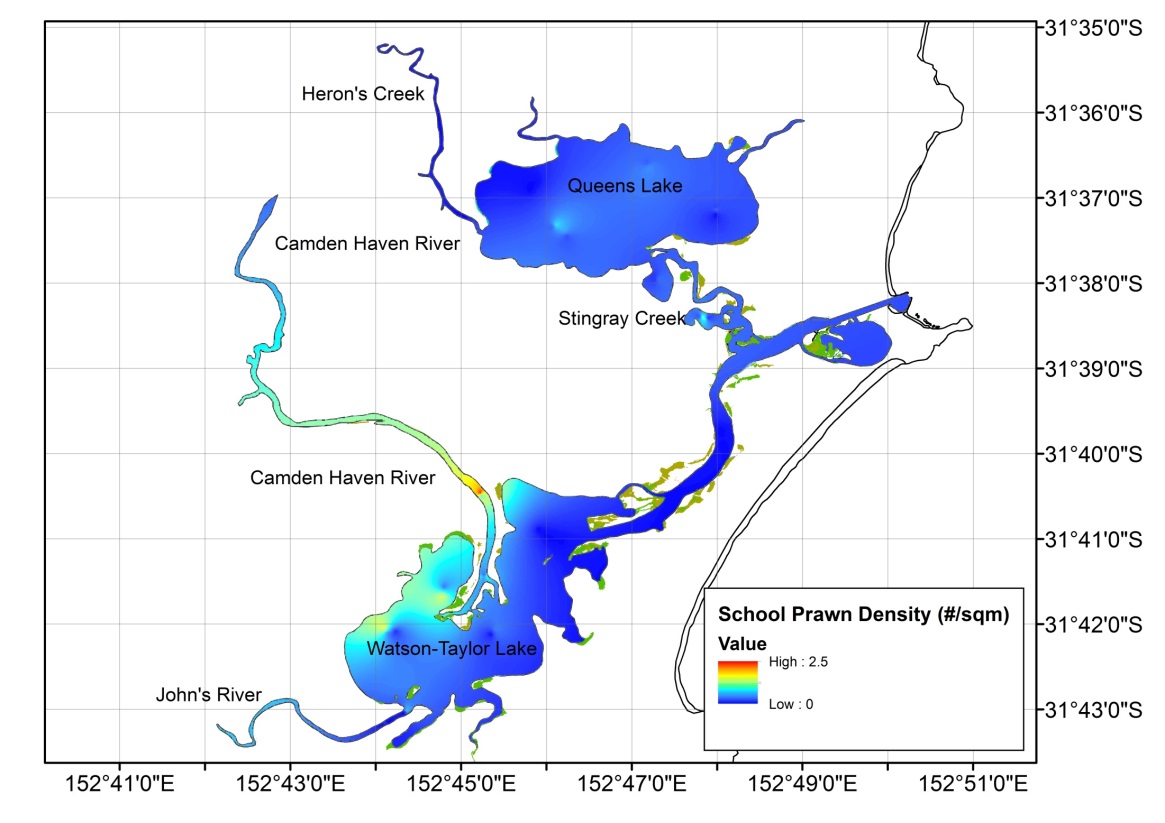
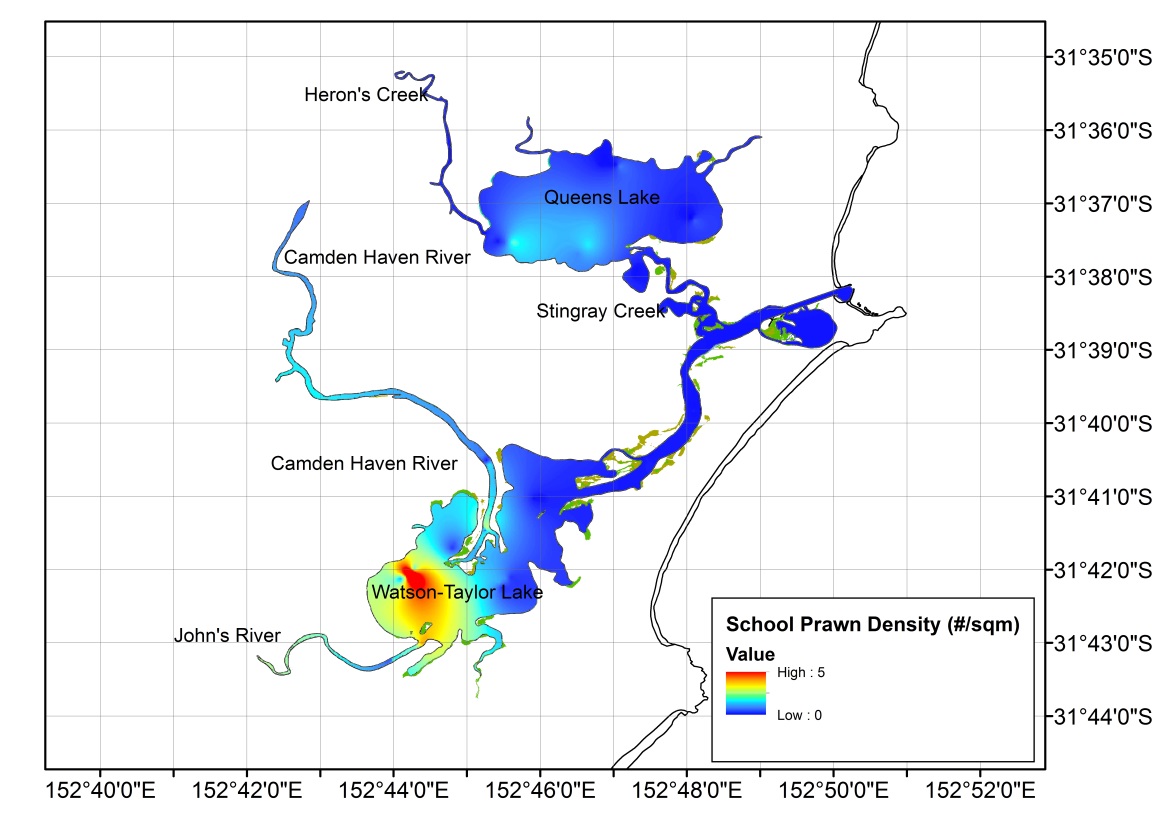
Further data analysis is being undertaken and will be reported at the next and subsequent milestones.
2. Evaluate whether post-recruitment processes in Camden Haven estuary may be adversely affectingSchool Prawn growth and survival
Water quality monitoring conducted under the project includes several components. Dissolved oxygen (DO) and temperature loggers are deployed at the mouths of Heron’s Creek, at the mouth of John’s River, and two are deployed at different locations in the delta at the mouth of the Camden Haven River. These loggers continuously monitor the DO levels in the water flowing out of these major tributaries to the system, and two these logger stations have recently had conductivity loggers added to them). The second component of the monitoring program involves profiling the water quality at each of the sampling stations in the Camden Haven estuary. This occurs during normal sampling trips, and also following major freshwater flow events (where possible). Finally, water samples are also collected at these stations and analysed for Aluminium.
Logger data to January 2016 has revealed several instances of low DO flowing from the tributaries into the main lakes (Figure 3). Even during this short period of time, DO dropped below 4 mg L-1 at all stations. The most severe drops, however, were observed at the mouth of Heron’s Creek and John’s River, with the later expelling a persistent plume of anoxic water into Watson Taylor Lake for 3 weeks in December and early January. The cause of this event is currently unclear, as there were no large rainfall events at this time which could have flushed low DO water from the tributaries. Mapping of DO across the estuary indicated hypoxic conditions in the main tributaries in November 2015 (Figure 4). Following the freshwater inflow event in early-January, however, DO levels in the rivers were much higher (Figure 5). Unfortunately, our sampling trips did not coincide with the anoxia event in December, so we could not map the spread or persistence of the anoxic plume from John’s River across Watson-Taylor Lake during this time. It is interesting to note that the DO levels in the two lakes were somewhat lower in January, possibly influenced by the discharge of anoxic water from the rivers. Surprisingly, with the exception of two measurements, pH has remained relatively stable and at acceptable levels.
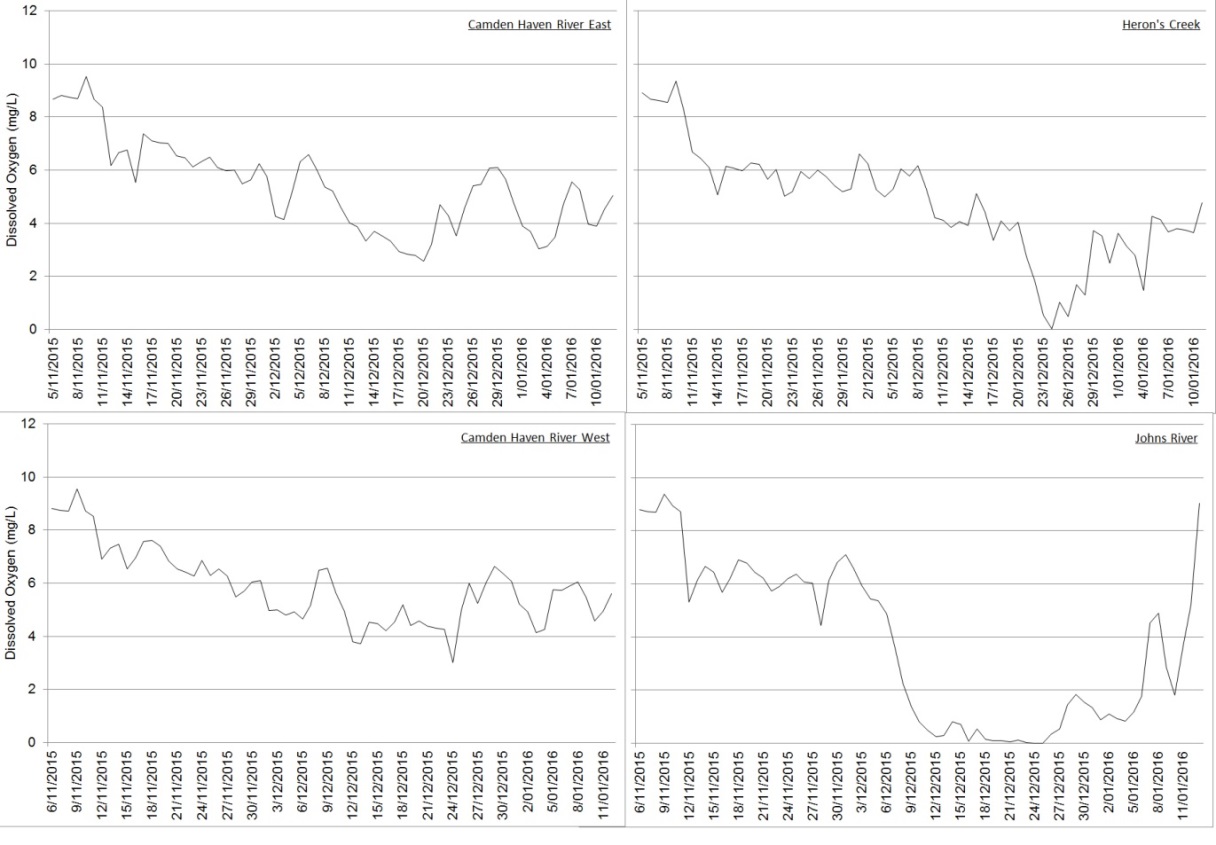
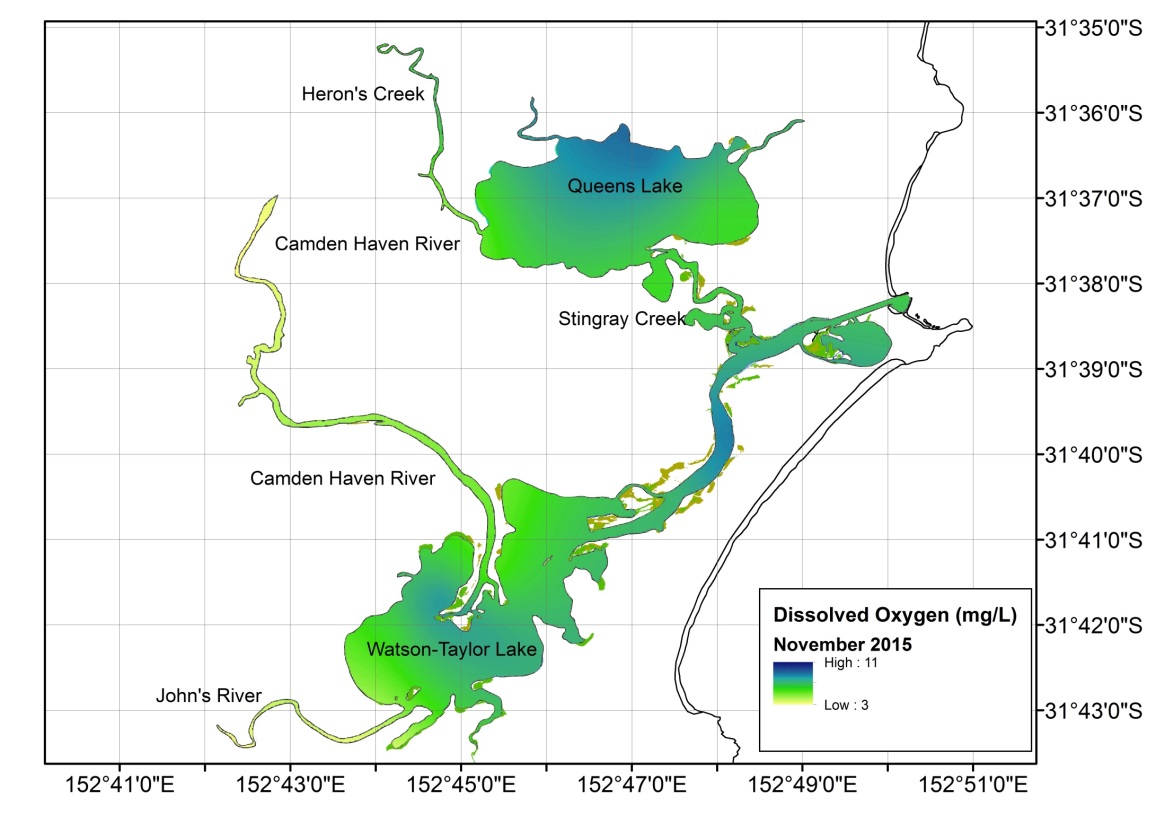
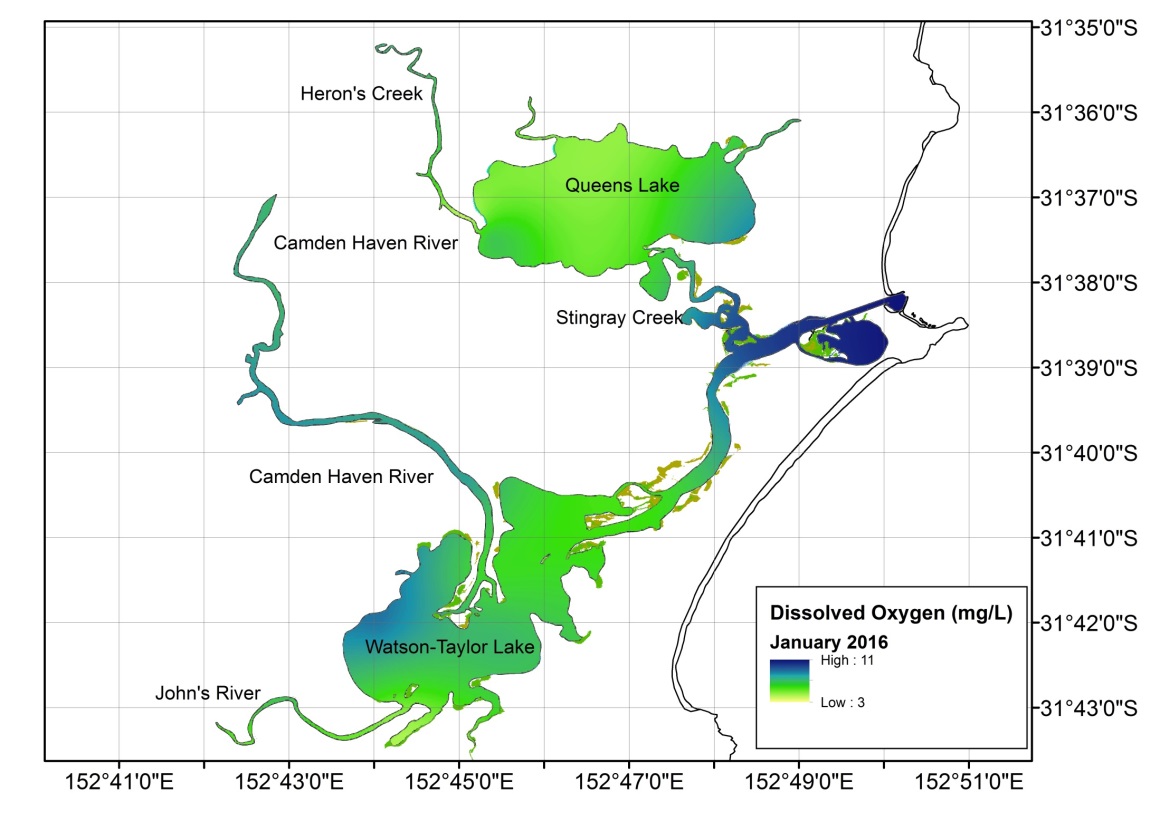
Aluminium has been tested from water samples collected at each station in November 2015 and January 2016. This data has also been provided as a map in Figures 6 and 7, and indicates that low concentrations were measured across the estuary in November 2015 (Figure 6), with a maximum concentration of 0.045 mg L-1. Following the rainfall event in January, however, elevated concentrations were measured across the estuary, with the highest concentrations measured in Camden Haven River, John’s River and Stingray Creek (Figure 7). These elevated concentrations measured following rainfall support the hypothesis put forward in the application, that elevated Aluminium concentrations may be present in the estuary as a result of acid sulfate soils in the catchment. The threshold for which deleterious effects on aquatic organisms may occur if exceeded is 0.1 mg L-1; this level was exceeded at 4 locations in the estuary, in January 2016.
In summary, water quality monitoring results to date indicate that anoxia, and elevated Aluminium concentrations may periodically occur in the Camden Haven estuary, and may adversely affect School Prawn productivity.
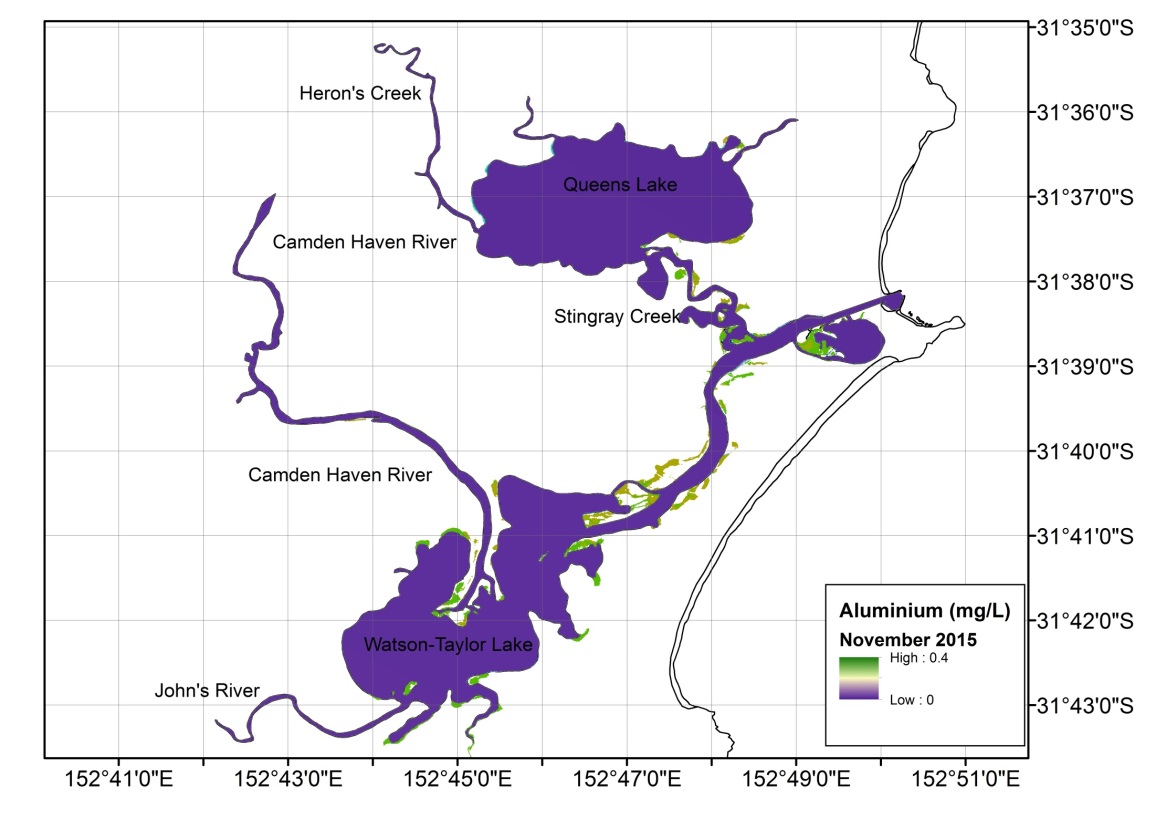
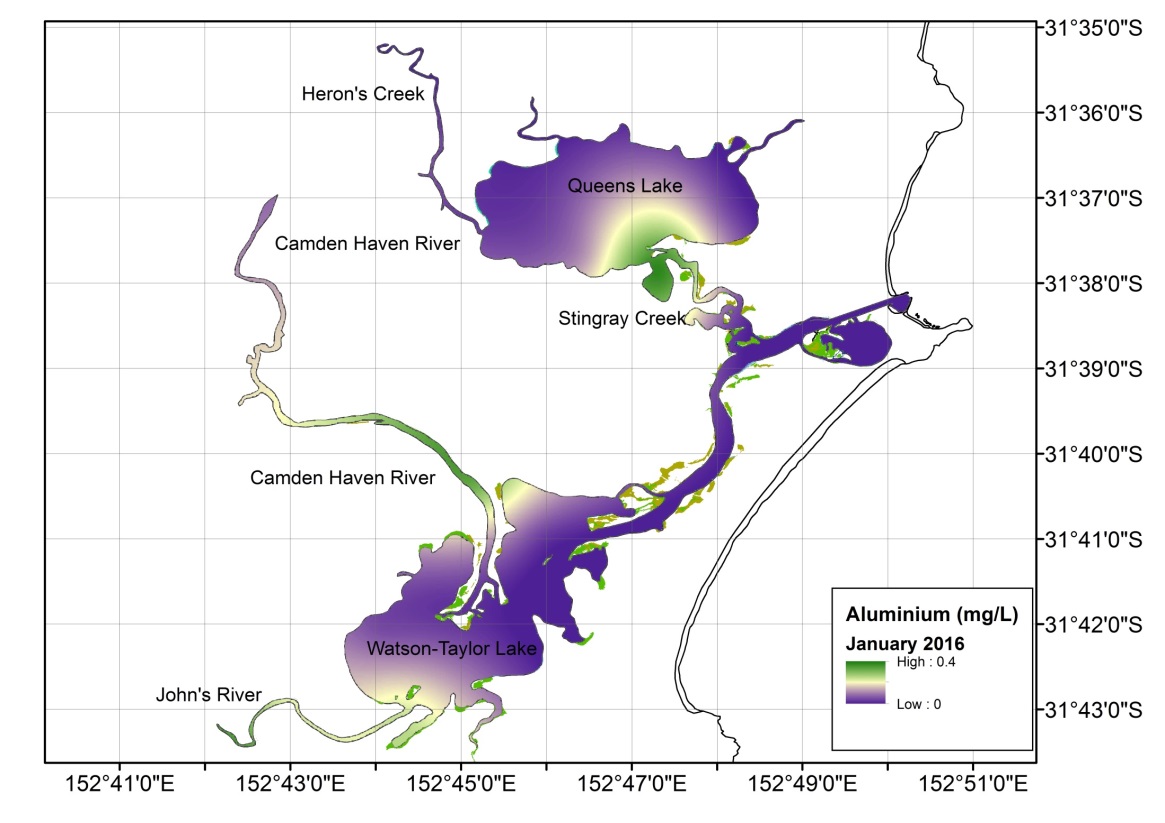
As outlined in the project application, a key area of work under Objective 2 was to assess the lethal and sub-lethal effects of Aluminium and pH on School Prawn. Work on this objective has commenced, but Aluminium toxicity testing has proven particularly challenging, principally due to Aluminium solubility issues in normal estuary water (i.e. higher salinity, slightly alkaline pH). Several trials have been run so far, with the latest trial being conducted under conditions of reduced pH.
Results to date indicate mortality between 0 and 70 % over 96 hrs can occur in School Prawn exposed to aluminium concentrations between 0.022 mg L-1 and 0.55 mg L-1 (controls in the trials had no mortality), however there is no clear relationship between concentration and mortality rate within this range at this stage. This indicates that the levels of Aluminium prawns measured in the Camden Haven estuary (particularly in the Camden Haven River, Johns River and western Watson-Taylor Lake), may in fact lead to mortality if exposure levels are maintained for several days. These interim results, however, should be interpreted with caution until the full suite of experimental studies are available. As outlined in the application, there may also be sub-lethal physiological effects on the prawns. This is being studied for School Prawn captured in Camden Haven aas well as experimental subjects exposed to different Aluminium concentrations, through metabolomics (for which methods are currently being developed). We are also conducting histological examination of the gills and hepatopancreas, and conducting phagocytosis trails to evaluate any effects of Aluminium toxicity on immune system function.
3. Synthesise research findings to provide recommendations to catchment, habitat and fishery managers regarding restoration of school prawn productivity
Several publications and/or communications have been carried out through the project during this milestone period.
Print media
A media release was prepared and distributed to several media outlets. The information was picked up by media outlets with a combined readership of over 50,000 people.
| Publication | Date | Readership |
|---|---|---|
| DPI media release | 30 September 2015 | n/a |
| Camden Haven Courier | 7 October 2015 | 12 495 |
| Lismore Northern Star | 16 October 2015 | 38 000 |
| University of Newcastle Environmental Science and Management blog | 22 October 2015 | n/a |

